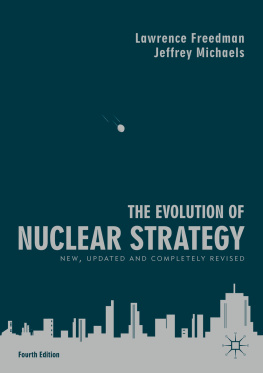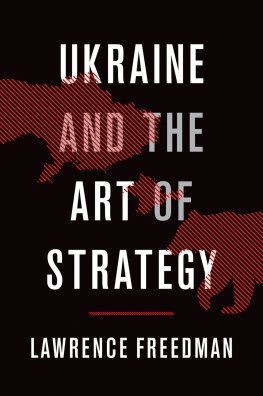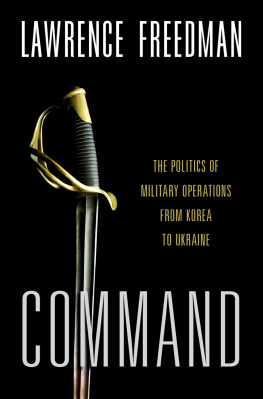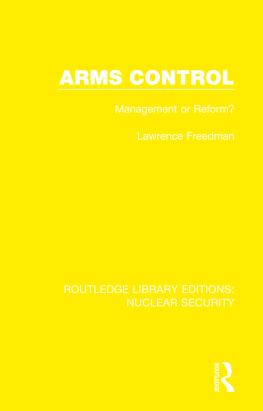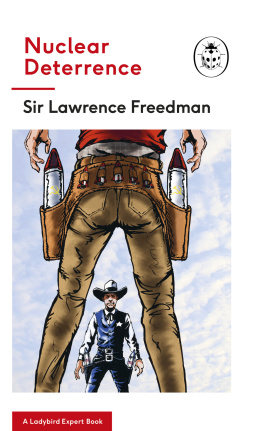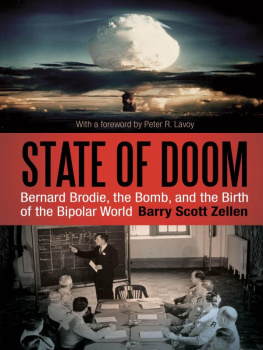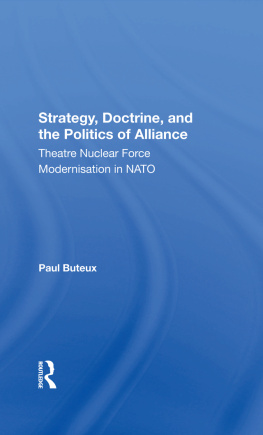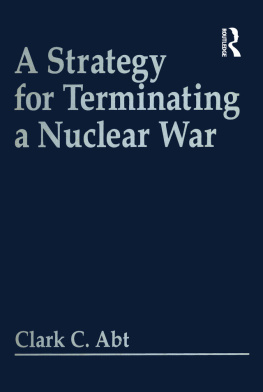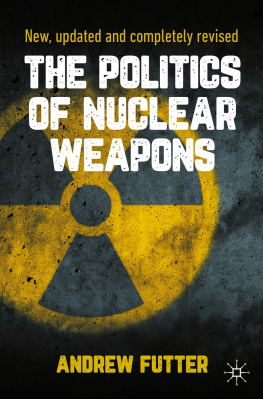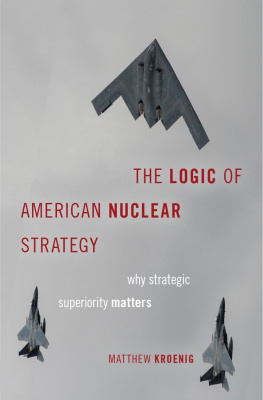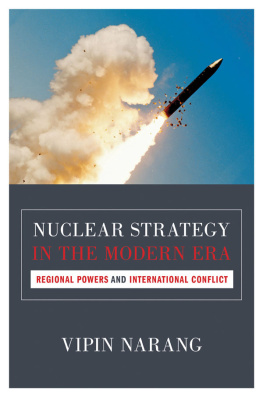Lawrence Freedman and Jeffrey Michaels
The Evolution of Nuclear Strategy New, Updated and Completely Revised 4th ed. 2019
Lawrence Freedman
Department of War Studies, Kings College London, London, UK
Jeffrey Michaels
Department of Defence Studies, Kings College London, London, UK
ISBN 978-1-137-57349-0 e-ISBN 978-1-137-57350-6
https://doi.org/10.1057/978-1-137-57350-6
First edition published 1981
Second edition 1989
Third edition 2003
Fourth edition 2019
The author(s) has/have asserted their right(s) to be identified as the author(s) of this work in accordance with the Copyright, Designs and Patents Act 1988.
The Editor(s) (if applicable) and The Author(s) 2019
This work is subject to copyright. All rights are solely and exclusively licensed by the Publisher, whether the whole or part of the material is concerned, specifically the rights of translation, reprinting, reuse of illustrations, recitation, broadcasting, reproduction on microfilms or in any other physical way, and transmission or information storage and retrieval, electronic adaptation, computer software, or by similar or dissimilar methodology now known or hereafter developed.
The use of general descriptive names, registered names, trademarks, service marks, etc. in this publication does not imply, even in the absence of a specific statement, that such names are exempt from the relevant protective laws and regulations and therefore free for general use.
The publisher, the authors and the editors are safe to assume that the advice and information in this book are believed to be true and accurate at the date of publication. Neither the publisher nor the authors or the editors give a warranty, express or implied, with respect to the material contained herein or for any errors or omissions that may have been made. The publisher remains neutral with regard to jurisdictional claims in published maps and institutional affiliations.
Cover illustration: design by Tjaa Krivec and Fatima Jamadar
This Palgrave Macmillan imprint is published by the registered company Springer Nature Limited
The registered company address is: The Campus, 4 Crinan Street, London, N1 9XW, United Kingdom
Preface
When this book was first published in 1981 it was 36 years since the first and still the only use of nuclear weapons in anger. At the time of publication tensions between the United States and the Soviet Union were on the rise and the nuclear issue had moved to the centre of political debate across the western world. A nuclear war was being actively discussed as a real possibility. This new edition is published with another 38 years having passed. There have been many terrible events during these years, including vicious conflicts that have left millions dead, wounded or displaced from their homes, but still a catastrophic nuclear war has been avoided. This fortunate state of affairs means that this fourth edition like the second and third can tell a continuing story of non-use while considering the preparations for war as well as attempts to reduce the risk through measures of disarmament and arms control. Unlike the second and third editions, however, which added new chapters to describe developments since 1981 this edition not only updates the story of nuclear weapons but also provides a complete revision of the original book.
There are a number of reasons for this updated and revised edition. The most obvious is that a mass of material has been published since 1981 on the first decades of the nuclear age, adding to our knowledge of the major strategic thinkers of the period and also the relationship between how the key issues were debated in public and how they were viewed by policy-makers in private. This is also true for the periods covered in the second and third editions. In particular we now know a lot more about the development of Soviet nuclear strategy so the account can be less one sided. The opportunity to compare the internal policy debates with what was being discussed in public makes it easier to evaluate the actual influence of some of the big books and ideas in contemporary strategic theory. Secondly, while it remains the case that the innovators in nuclear strategy have largely been American, with many more nuclear states and the Cold War over, it is important to review not just superpower strategies but the whole range of approaches to the nuclear issue, including those of states that decided that they could abandon their weapons programmes. Third, it is hard to get a unity of style when bringing together chapters written at different times over the past forty or so years.
Both Freedman and Michaels wish to acknowledge their debt to their colleagues and students at Kings College London. Michaels is also grateful for the backing of the John D. and Catherine T. MacArthur Foundation and the support of Professor Wyn Bowen.
Lawrence Freedman
Jeffrey Michaels
London, UK London, UK
Introduction
Just after 7 am on 6 August 1945 a single aircraft flew over the Japanese city of Hiroshima. This B-29, known as Straight Flush, was checking weather conditions over the primary target for the dropping of the first atomic bomb. Two other aircraft were checking the conditions over the second and third possible targets. The all clear was sounded in the city below as the aircraft flew away. Another B-29, named Enola Gay after the mother of the pilot, Colonel Paul Tibbets, now prepared to drop the bomb it was carrying. Two other B-29s followed just behind carrying scientific instrumentation and cameras. One was named Great Artiste and the other was later named as Necessary Evil. An hour later at 8.15 am the bomb was dropped. At least 66,000 people died almost immediately from the explosion and fire-storm that followed. Tens of thousands more died in the aftermath, and many died over subsequent years as a result of their injuries and exposure to high doses of radiation. Three days after the first explosion, a second bomb was dropped on the Japanese city of Nagasaki. The immediate dead numbered some 40,000 people. The hilly terrain meant that the devastation was not as complete as with Hiroshima, although the explosion was larger. About 40 per cent of the citys structures were destroyed or severely damaged, as against 80 per cent in Hiroshima. On 15 August Emperor Hirohito announced Japans surrender.
Thus began the nuclear age. It opened with key propositions: the bombs effects were devastating; cities were their natural targets; there was no obvious defence; and they could win wars. Each of these propositions could be qualified or challenged. When announcing the destruction of Hiroshima President Truman had described the target as an important military base. This choice of words, indicating unease about targeting civilians directly, foreshadowed later debates about the purposes that might be served if nuclear weapons were directed against the enemys armed forces. Those who had planned the attack were surprised by the death toll. They had assumed that people would have taken shelter, not realising how little alarm would be caused by the appearance of so few aircraft. As the weapons became even more powerful the possibility of surviving an attack declined, but concepts of defence based on intercepting weapons before they reached their targets continued to be explored. Later a debate began about whether the destruction of these two cities really did cause the Japanese surrender, especially as the Soviet Union coincidentally declared war on Japan. But first impressions count, and these reinforced the view that atomic bombs were transformational weapons. Despite their apparent ability to win wars the horrific human consequences of their use raised questions from the start as to whether they could ever be treated as normal weapons of war. Soon the emphasis was on deterring wars rather than winning them. This preference was reinforced once the Soviet Union acquired its own nuclear capabilities and the US monopoly was lost. In this respect the context of the developing Cold War between these two countries and their respective alliances shaped thinking about nuclear weapons. If the victors of 1945 had avoided a new round of conflict then they might have been able to work together to impose stricter controls on how nuclear energy was exploited for military purposes. Proposals were made but they soon foundered on Cold War suspicions. In these ways the big issuesof targeting, survival, deterrence and controlwere framed from early on in the nuclear age and they continue to shape debates about their development, deployment and potential use.

